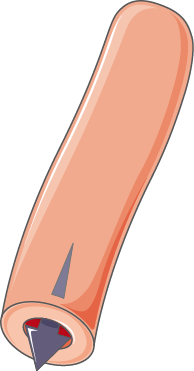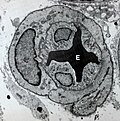Vasoconstriction: Difference between revisions
CSV import |
CSV import |
||
| Line 40: | Line 40: | ||
[[Category:Cardiovascular physiology]] | [[Category:Cardiovascular physiology]] | ||
<gallery> | |||
File:Cardiovascular_system_-_Vasoconstriction_1_--_Smart-Servier.png|Vasoconstriction illustration 1 | |||
File:Cardiovascular_system_-_Vasoconstriction_3_--_Smart-Servier.png|Vasoconstriction illustration 3 | |||
File:Microvessel.jpg|Microvessel | |||
</gallery> | |||
Latest revision as of 04:21, 18 February 2025
Vasoconstriction[edit]

Vasoconstriction is the narrowing of the blood vessels resulting from contraction of the muscular wall of the vessels, particularly the large arteries and small arterioles. This process is the opposite of vasodilation, which is the widening of blood vessels. Vasoconstriction is a crucial mechanism in the regulation of blood pressure and blood flow.
Mechanism[edit]
Vasoconstriction is primarily mediated by the sympathetic nervous system. When the body needs to increase blood pressure or reduce blood flow to certain areas, the sympathetic nervous system releases norepinephrine, which binds to adrenergic receptors on the smooth muscle cells of the blood vessels, causing them to contract. Other factors that can induce vasoconstriction include hormones such as angiotensin II, vasopressin, and endothelin.
Physiological Role[edit]
Vasoconstriction plays a vital role in maintaining homeostasis within the body. It helps regulate blood pressure by adjusting the diameter of blood vessels, thus controlling the resistance to blood flow. During cold exposure, vasoconstriction reduces blood flow to the skin to minimize heat loss. In situations of blood loss or dehydration, vasoconstriction helps maintain blood pressure by reducing the volume of the circulatory system.
Pathological Conditions[edit]

Excessive or prolonged vasoconstriction can lead to hypertension (high blood pressure) and contribute to cardiovascular disease. Conditions such as Raynaud's phenomenon involve abnormal vasoconstriction, leading to reduced blood flow to extremities and causing symptoms like cold fingers and toes.
Pharmacological Agents[edit]
Several drugs can induce vasoconstriction, including decongestants like pseudoephedrine and phenylephrine, which are used to relieve nasal congestion by reducing blood flow to the nasal passages. Conversely, vasodilators are used to treat conditions like hypertension by relaxing blood vessels and reducing resistance to blood flow.
Related Pages[edit]
References[edit]
- Guyton, A. C., & Hall, J. E. (2006). Textbook of Medical Physiology. Elsevier Saunders.
- Hall, J. E. (2011). Guyton and Hall Textbook of Medical Physiology. Elsevier Health Sciences.

| Physiology of the cardiovascular system | ||||||||||||||
|---|---|---|---|---|---|---|---|---|---|---|---|---|---|---|
|
-
Vasoconstriction illustration 1
-
Vasoconstriction illustration 3
-
Microvessel


